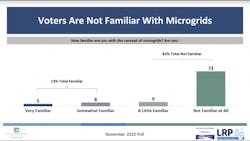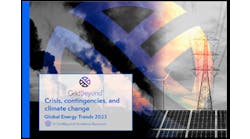Opportunities abound for microgrids in the US. But development lags frustrate microgrid adoption. As a result, too many businesses and communities continue to struggle — unnecessarily — with power outages.
By durantelallera/Shutterstock.com
What’s the problem and what can the microgrid community do to overcome it?
Since people often leave conferences inspired, but not knowing what to do with their inspiration, Microgrid Knowledge asked industry leaders to offer a call to action at the close of last week’s Microgrid 2020 Global.
The request evoked a lively conversation among the Microgrid Knowledge Advisory Board members, which include representatives from Ameresco, Concord Engineering, Powersecure, S&C Electric, Schneider Electric and Siemens.
At the conference’s grand finale session, the board issued a call to action for those in the industry to work within their sphere of influence to focus government attention on two key areas:
- Continuing to incentivize demand side resources to create a more level playing field between supply and demand (Such as FERC 2222)
- Incorporating resilience and microgrids in state/federal infrastructure programs and utility integrated resource plans and transmission and distribution planning.
What blocks microgrids and why?
One obstruction is archaic rules and regulations, conceived long before technology advancements that give businesses and consumers more control over their energy supply, a key benefit of microgrids. Many of these obstructions involve utility requirements, rate structures, and territorial restrictions.
“The crown jewel for the utility has always been…their exclusive franchise territory,” said Michael Bakas, executive vice president, Ameresco.
Michael Bakas, Ameresco, executive vice president
Franchise rights also can serve as a material barrier to comprehensive microgrids, he said.
Industry restructuring opened the way, somewhat, for non-utility players. But the move to deregulate the power sector stalled with only 13 states and the District of Columbia offering full competitive retail choice.
In any case, even deregulation did not contemplate the microgrid. Both competitive and regulated markets in the US create unintended obstructions to the technology.
“We’re finding in the traditional regulated markets, the proposed and approved microgrid projects primarily are owned and operated by distribution utilities, which in some cases are allowed to rate base at least some of the costs. In the competitive markets, the current regulatory climate does not address many issues that will jump-start microgrid development in a more robust manner,” Bakas said.
Multiple playing fields
Over-the-fence rules, for example, stop non-utility players from developing microgrids that serve customers across utility rights-of-way. This becomes a problem for a community microgrid or complex campus with buildings that cross roads and property lines.
Meanwhile, in most deregulated states utilities cannot own generation, which can serve as an obstruction to their attempts to build microgrids. Utility microgrid plans also have collapsed after regulators denied the utility rate recovery, arguing that the microgrid only served a portion of customers so therefore its costs should not be borne by all.
Bakas listed a range of other issues that can arise out of the complex legal relationship between microgrids, utilities and the regulations that govern them, including issues involving interconnection, standby charges and exit fees.
Connecting with utilities
Erik Svanholm, vice president, non-wires alternatives for S&C Electric
One of the most frequent sources of acrimony between utilities and microgrid developers involves interconnection of microgrids to the utility distribution system. Microgrid developers complain about delays; utilities say the delays are necessary to ensure safety and reliability.
“It’s an easy starting point to say that utilities need to be more accommodating in this regard for private developers or end-users to connect energy systems to the grid and provide interactivity there,” said Erik Svanholm, vice president of non-wires alternatives, S&C Electric Company. “But there’s also a very practical, technical aspect to this that we can’t ignore. Utilities have that unglamorous job of ensuring that all of us have the lights on 24/7, 365.”
“And so, I think dialogue is really a key factor, so that we can find standardized, repeatable ways, consistent and predictable ways, so that developers of microgrids or end-users developing their own systems can know what they’re dealing with, and the utilities can know what they’re dealing with.” Svanholm said. “What if we could get to a place where we had specification standards for grid interconnections that were useful across multiple jurisdictions?
Michael Boswell,
vice president, distributed generation, Concord Engineering
Skewed incentives?
Another problem: current regulatory structures incentivize investor-owned utilities to make large capital investments, which can disincentivize their pursuit of smaller projects, like microgrids and distributed energy resources.
Municipal utilities, cooperatives and public power utilities do not operate under the same profit structure as investor owned utilities. So they tend to be “a bit more nimble, and a lot more flexible” and could prove to be a source of data, information and business models for regulators, said Michael Boswell, vice president – distributed generation projects, Concord Engineering.
Technically, we can make this stuff work, it’s not a problem. It’s, ‘What is the business model’?” Boswell said.
Added Ameresco’s Bakas, “We’ve got to figure out how you allow the utility to play in this world, or at least transition to this world over a certain period of time.”
“I don’t see it as necessarily a utility against other third parties, it’s really, how do they come together and work together to really attack this problem and to incentivize utilities?” added Jim Taylor, vice president of business solutions, digital grid, Siemens Industry.
Jim Taylor, vice president, business solutions, digital grid, Siemens Industry
Wait…what’s a microgrid?
The US has been on the verge of a federal infrastructure spending plan for several years. Expectations are high that it’s time has come given a need to stimulate job growth in the wake of Covid-19 and a new administration coming into Washington, D.C.
The bad news is that many special interests will elbow in for their place at the table, and the microgrid industry remains relatively new, small and unknown. The good news is that when people finally do learn about microgrids, they like the idea, and that cuts across partisan lines, according to a November survey by the Civil Society Institute that was presented at Microgrid 2020 Global.
And it appears Washington, DC is beginning to take more notice of microgrids. For example, FEMA’s $500 million Building Resilient Infrastructure and Communities (BRIC) grant program offers opportunities for microgrids, energy storage, backup power, and other advanced energy solutions. In addition Democrats in Congress have introduced the Moving Forward Act — a $1.5 trillion infrastructure plan that includes funding resilience measures and microgrids.
The right signals from Washington
Just mentioning resiliency as a factor in government infrastructure funding “sends a very strong signal to all stakeholders that the status quo is over,” said S&C’s Svanholm.
Indeed, several panelists said that ‘resilience’ and the perception of its importance within US infrastructures, is the entry point for microgrids.
Mark Feasel, president, smart grid, Schneider Electric, noted that technology is changing what we consider to be critical infrastructure, particularly since Covid-19, which has brought about shifts in the way we work and seek services.
“As we think about this new world, as we build infrastructure out, what does resilience mean and how do we think about that? Maybe five years ago, we’d think about making large infrastructure resilient — a big hospital, a big stadium — but increasingly we’re doing healthcare at the edge, we’re doing healthcare and small clinics, we’re in the home,” Feasel said.
In this changing world, how does the microgrid industry get regulators, policymakers and utilities on the same page when it comes to resilience?
Feasel suggested that resilience be defined and incorporated into third party standards for microgrids. He pointed to the PEER system, operated by the US Green Building Council. Similar to the organization’s well-known LEED program, created for green buildings, the PEER system ranks microgrids and other energy systems by quantifying various attributes.
Eric Dupont, executive vice president and chief commercial officer, PowerSecure
Balancing act
Eric Dupont, PowerSecure’s executive vice president and chief commercial officer, noted that the need for resilience will heighten as society electrifies transportation and buildings. “It really creates a next level of business risk,” Dupont said. “Again, I think it’s back to our earlier conversation about bringing the utility back into the mix.”
“It’s a balancing act that we have to go through as we look at putting these projects together — making sure that we have all these different stakeholder aspects brought to the table in order to build the right solution for the customer and the utility,” he said.
The bottom line for the microgrid community? Complex rules, some outdated, play a significant role in determining the availability of microgrids to society. Equally significant, large swaths of the population, including many in government, still know little about microgrids. Ensuring a fair playing field and a place at the table may require an industry-wide effort, a conversation repeated from town hall to Congress.
Microgrid 2020 Global is available on demand for purchase here.
















